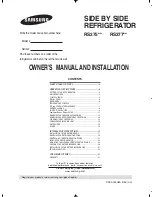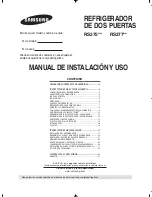
8
4. Align and replace the top left hinge as shown (see Graphic 4).
Tighten screws.
Style 1
■
Reconnect both ground wires.
■
Reconnect wiring plug.
Style 2
■
Reconnect wiring plug.
5. Replace left hinge cover and screws.
6. Replace the refrigerator door by carefully lifting the door onto
the bottom right hinge.
7. Align and replace the top right hinge as shown (see Graphic
6). Tighten screws.
8. Replace hinge cover and screws. Tighten screws.
9. Plug into a grounded 3 prong outlet.
Door Closing
Your refrigerator has two front adjustable rollers — one on the
right and one on the left. If your refrigerator seems unsteady or if
you want the doors to close more easily, adjust the refrigerator's
tilt using the instructions below:
1. Move the refrigerator into its final position.
2. The two leveling screws are part of the front roller assemblies
which are at the base of the refrigerator on either side (see
Graphic 8).
3. Use a hex-head socket wrench to adjust the leveling screws.
Turn the leveling screw to the right to raise that side of the
refrigerator or turn the leveling screw to the left to lower that
side. It may take several turns of the leveling screws to adjust
the tilt of the refrigerator (see Graphic 8).
NOTE: Having someone push against the top of the
refrigerator takes some weight off the leveling screws and
rollers. This makes it easier to adjust the screws.
4. Open both doors again and check to make sure that they
close as easily as you like. If not, tilt the refrigerator slightly
more to the rear by turning both leveling screws to the right. It
may take several more turns, and you should turn both
leveling screws the same amount.
5. Replace the base grille.
NOTE: Be sure to refasten the Tech Sheet behind the base grille.
Water Supply Connection
Read all directions before you begin.
IMPORTANT: If you turn the refrigerator on before the water line
is connected, turn the ice maker OFF.
Connecting to Water Line
1. Unplug refrigerator or disconnect power.
2. Turn OFF main water supply. Turn ON nearest faucet long
enough to clear line of water.
3. Locate a ½ in. to 1
¹⁄₄
in. (1.25 cm to 3.18 cm) vertical COLD
water pipe near the refrigerator.
NOTE: Horizontal pipe will work, but drill on the top side of
the pipe, not the bottom. This will help keep water away from
the drill and normal sediment from collecting in the valve.
4. Determine the length of copper tubing you need. Measure
from the connection on the lower left rear of refrigerator to the
water pipe. Add 7 ft. (2.1 m) to allow for cleaning. Use
¹⁄₄
in.
(6.35 mm) O.D. (outside diameter) copper tubing. Be sure
both ends of copper tubing are cut square.
5. Using a grounded drill, drill a
¹⁄₄
in. hole in the cold water pipe
you have selected.
6. Fasten the shutoff valve to the cold water pipe with the pipe
clamp. Be sure the outlet end is solidly in the
¹⁄₄
in. drilled hole
in the water pipe and that the washer is under the pipe clamp.
Tighten the packing nut. Tighten the pipe clamp screws
carefully and evenly so washer makes a watertight seal. Do
not overtighten or you may crush the copper tubing.
7. Slip the compression sleeve and compression nut on the
copper tubing as shown. Insert the end of the tubing into the
outlet end squarely as far as it will go. Screw compression nut
onto outlet end with adjustable wrench. Do not overtighten.
8. Place the free end of the tubing in a container or sink, and
turn ON the main water supply. Flush the tubing until water is
clear. Turn OFF the shutoff valve on the water pipe. Coil the
copper tubing.
1. Do not remove screw 1
2. Ground wires
3. Green ground wire screw
4. Wiring plug
1. Do not remove screw 1
2. Wiring plug
WARNING
Electrical Shock Hazard
Reconnect both ground wires.
Failure to do so can result in death or
electrical shock.
2
1
3
4
1
2
1. Cold water pipe
2. Pipe clamp
3. Copper tubing
4. Compression nut
5. Compression sleeve
6. Shutoff valve
7. Packing nut









































